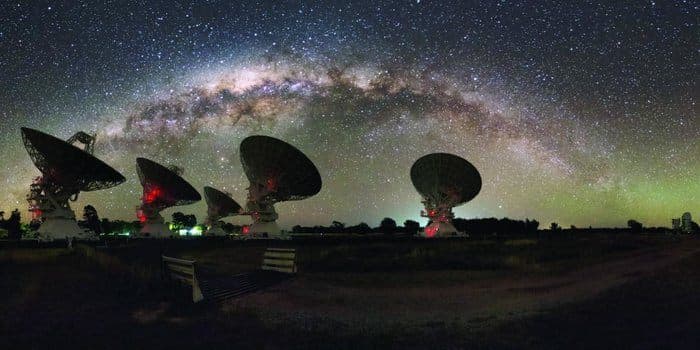Scientists Determine The Location Of A Fast Radio Burst For The First Time
A group of Scientists from the CSIRO, Australia and the National Astronomical Observatory in Japan has finally tracked down a ‘fast radio burst’, which is an impulse of radio waves emanating from the distant universe. For the first time in history, the origin of these high energy flashes was uncovered. Using CSIRO radio telescopes in eastern Australia and Japan's Subaru telescope in Hawaii (NAO), the team could confirm their results.
Dr Simon Johnston, head of Astrophysics at CSIRO explained that till the time of discovery, FRBs had only given them a clue about their characteristics but the exact reason for their existence was completely submerged in darkness. Since its discovery in 2007, only 16 such bursts were detected. However, according to the astronomers’ calculation these bursts occur as many as 10,000 times a day, across the entire observable universe.

CSIRO's Compact Array telescope
The team finally recorded a burst that had originated in a galaxy positioned six billion light-years away. Modern physics states that our universe consists of 70 percent dark energy, 25 percent dark matter and 5 percent ordinary matter. The current results regarding FRBs could well unearth the mystery of the elusive missing matter.
This eerie concept arises from performing a mathematical sum of all the existing matter in the universe. In reality, the sum of all matter including all the celestial bodies does not equate with the observed quantity of matter. Rather, it falls way short of the matter that should be out there.
Dr Evan Keane from the SKA Organisation expressed that while calculating FRBs, the team had inferred that there is definitely some missing matter lurking somewhere which will eventually prove the equality. In the future, the team would like to study other bursts and analyse the minute details in order to draw significant conclusions. The research was published in the 24th February issue of the’ Nature’ Journal.
Source: #-Link-Snipped-#
Dr Simon Johnston, head of Astrophysics at CSIRO explained that till the time of discovery, FRBs had only given them a clue about their characteristics but the exact reason for their existence was completely submerged in darkness. Since its discovery in 2007, only 16 such bursts were detected. However, according to the astronomers’ calculation these bursts occur as many as 10,000 times a day, across the entire observable universe.

CSIRO's Compact Array telescope
This eerie concept arises from performing a mathematical sum of all the existing matter in the universe. In reality, the sum of all matter including all the celestial bodies does not equate with the observed quantity of matter. Rather, it falls way short of the matter that should be out there.
Dr Evan Keane from the SKA Organisation expressed that while calculating FRBs, the team had inferred that there is definitely some missing matter lurking somewhere which will eventually prove the equality. In the future, the team would like to study other bursts and analyse the minute details in order to draw significant conclusions. The research was published in the 24th February issue of the’ Nature’ Journal.
Source: #-Link-Snipped-#
0
